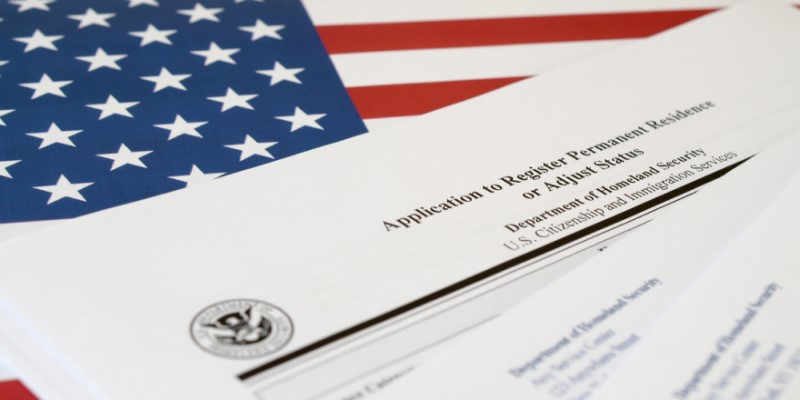
By Kyle Walker
One of the key features of the EB-5 Reform and Integrity Act (RIA) of 2022 is the ability for EB-5 investors to concurrently file a Form I-485, Application to Register Permanent Residence or Adjustment Status (AOS) application when the Form I-526E, Immigrant Petition by Regional Center Investor is filed. In the past, the EB-5 investor was required to wait until the Form I-526 (Form I-526E is the new form created under the RIA to replace the Form I-526 for Regional Center investors) was approved before an AOS application could be filed, which, due to processing times, extended the timeline for an investor to receive the benefits of conditional permanent residency.
Who may concurrently file for EB-5?
Concurrent filing of the two applications may only occur if the EB-5 investor and any dependent family members are in the United States. In addition, all individuals filing an AOS application must be in the U.S. in a lawful status, which means that they may not be in the U.S. on visa waiver, because an individual in the U.S. under visa waiver is not in a visa status, and thus may not “adjust” to being a lawful permanent resident (green card holder). Another item to note is that while the AOS application commonly refers to Form I-485, travel and work authorization documents are separate forms that are filed with Form I-485. While it is not required that they all be filed together, there is no additional cost to file forms I-131, Application for Travel Document (Advance Parole/Travel Authorization) and I-765, Application for Employment Authorization (Employment Authorization Document – EAD) at the same time as the Form I-485 and filing together helps achieve faster adjudication.
Note that if the EB-5 investor and eligible family members are in the U.S. in H or L statuses, which are considered “dual intent,” meaning that a person holding this status may have the intent of seeking lawful permanent resident status, then an AOS application may be filed immediately with the I-526E. If the EB-5 investor and eligible family members are in any other status but H or L, they are likely in a “nonimmigrant intent” status, which means that their intent should be to leave the U.S. at the conclusion of their stay and that they do not intend to seek lawful permanent residence status. For individuals in a nonimmigrant intent status (i.e., B, F, TN), it is recommended by most immigration attorneys that they wait 90 days prior to filing the AOS application(s).
How does status affect the petitioner after filing for EB-5?
After filing an AOS application, the petitioners are considered an “Applicant for Adjustment,” and are able to lawfully remain in the United States. Depending on the status that the EB-5 investor “adjusted” from, they may be able to work and travel immediately after filing their AOS. Those in H and L statuses will have the most freedom because these individuals will be able to continue working (so long as they are in valid H and L statuses and have the proper work authorization pursuant to those statuses) and traveling in and out of the U.S. (with valid visas).
Those who are in a nonimmigrant intent status will be able to continue their activities for the duration that remains, until work and travel authorization are received, which will be explained in the next section. For example, a student in F-1 status will be able to continue their studies, but once the F-1 studies conclude, the student may not be able to work unless they obtain OPT; if OPT is not obtained, the AOS filing allows the student to remain in the U.S., but they will not be able to study, travel, or work until authorization is received (approval of work and/or travel authorization). Another example is a person in TN status – once the status is expired, the person will not be able to renew their status, and while the AOS filing allows them to remain in the U.S. lawfully, they will not be able to work or travel until authorization is received (approval of the work and/or travel authorization). If a person in a nonimmigrant-intent-status travels before their travel authorization is approved, then they would be considered to have “abandoned” their AOS application and will thus need to refile (will need to wait the 90 days again upon reentering the U.S.).
When is each concurrent benefit realized for EB-5?
After filing the I-526E and the AOS applications, the EB-5 investor and eligible family members should expect to receive receipt notices within 2-4 weeks. The receipt notices will be separate for each form filed: I-526E, I-485, I-131 (if applicable), I-765 (if applicable). An I-485 Receipt Notice, concurrently filed with an I-526E, establishes the ability for the EB-5 investor and eligible family members to remain in the United States. In addition, biometrics notices will be issued for the AOS application, which the applicant must attend for the application to be adjudicated. If the applicant cannot attend, they may reschedule, but doing so may delay approval.
Unlike, the right to indefinitely remain in the United States, work and travel authorization require approvals to occur and documents to be issued. Approvals for both work and travel authorization can take as little as 3 months, to over 18 months—even though USCIS does post processing times on their website, please remember that these are merely averages of adjudication times. Note that when viewing processing times – choose the service center that appears on the receipt notice: https://egov.uscis.gov/processing-times/.
After work and travel authorization (Forms I-765 and I-131) are approved, approval notices and EAD cards (with travel authorization), or EAD cards and a separate Advance Parole document, will be issued. The important thing to note here is that the approval notices themselves do not allow for work or travel authorization, and that the actual document (the EAD and/or Advance Parole document) in hand must be present for work and travel into the U.S. To be clear, domestic travel is fine without prior approval but returning to the U.S. from an international location requires travel authorization. Please note the expiration dates of these documents; if they need to be renewed, it is recommended by immigration attorneys to do so as soon as possible. While EAD extensions (if filed timely), are afforded an automatic extension of work, this does not apply to travel authorization.
University tuition and international status?
Once the I-485 is filed, the EB-5 investor, and their dependents, are no longer considered an international student and are no longer subject to the Student and Exchange Visitor Program (SEVIS) or the international student office. Therefore, after concurrently filing the I-526E and I-485 the EB-5 Investor, and their eligible family members, will no longer be charged international tuition rates and can qualify for out-of-state tuition. To qualify for in-state tuition is a matter of establishing residency in the state, and each state has different standards for doing so.
Will concurrently filing “lock in” my green card?
The visa bulletin is a complicated tool the Department of State uses to calculate the number of visas given in a certain year given demand. By filing the I-526E petition, the date of receipt will establish the “Priority Date” of the EB-5 petition, or the “immigrant visa” petition, which can be found on the I-526E receipt notice. The priority date “locks in” the place in line for green card processing upon approval.
Concurrently filing an AOS application means that an individual has the right to stay in the U.S. as an applicant for adjustment and may be able to work and travel internationally. It does not, however, “lock in” a spot in the case a priority date retrogresses. If the AOS application is not approved before retrogression, then the applicant will need to wait for their priority date to be current for their AOS application to resume processing. This applies not only to the EB-5 investor petitions, but to all immigrant visa petitions regardless of visa category.

Author: Kyle Walker is the co-founder and managing partner of Green Card Fund, LLC. In addition to his diverse responsibilities as CEO of NewGen Worldwide, he leads NewGen’s EB-5 business, Green Card Fund. Over the years, Walker has been involved with the Greater Phoenix Economic Council’s (GPEC) International Leadership Council, the board of directors of Invest in the USA (IIUSA), the founding circle of Opportunity Zone Association of America (OZAA), and supporting his business partners in their leadership of the Asian American Hotel Owners Association (AAHOA) and American Hotel and Lodging Association (AHLA). With over 15 years of EB-5 experience, deep hospitality experience, and a personal passion for travel and the outdoors, Walker is uniquely positioned to deliver successful EB-5 outcomes with the Terra Vi hotel projects.
DISCLAIMER: The views expressed in this article are solely the views of the author and do not necessarily represent the views of the publisher, its employees. or its affiliates. The information found on this website is intended to be general information; it is not legal or financial advice. Specific legal or financial advice can only be given by a licensed professional with full knowledge of all the facts and circumstances of your particular situation. You should seek consultation with legal, immigration, and financial experts prior to participating in the EB-5 program Posting a question on this website does not create an attorney-client relationship. All questions you post will be available to the public; do not include confidential information in your question.








